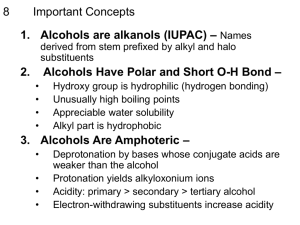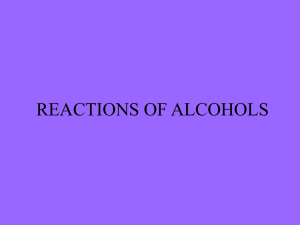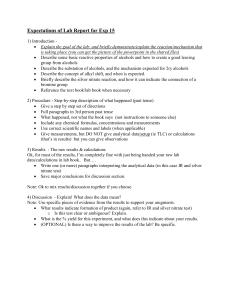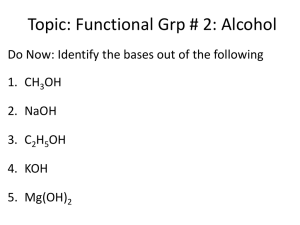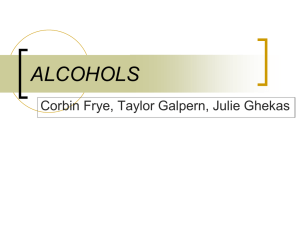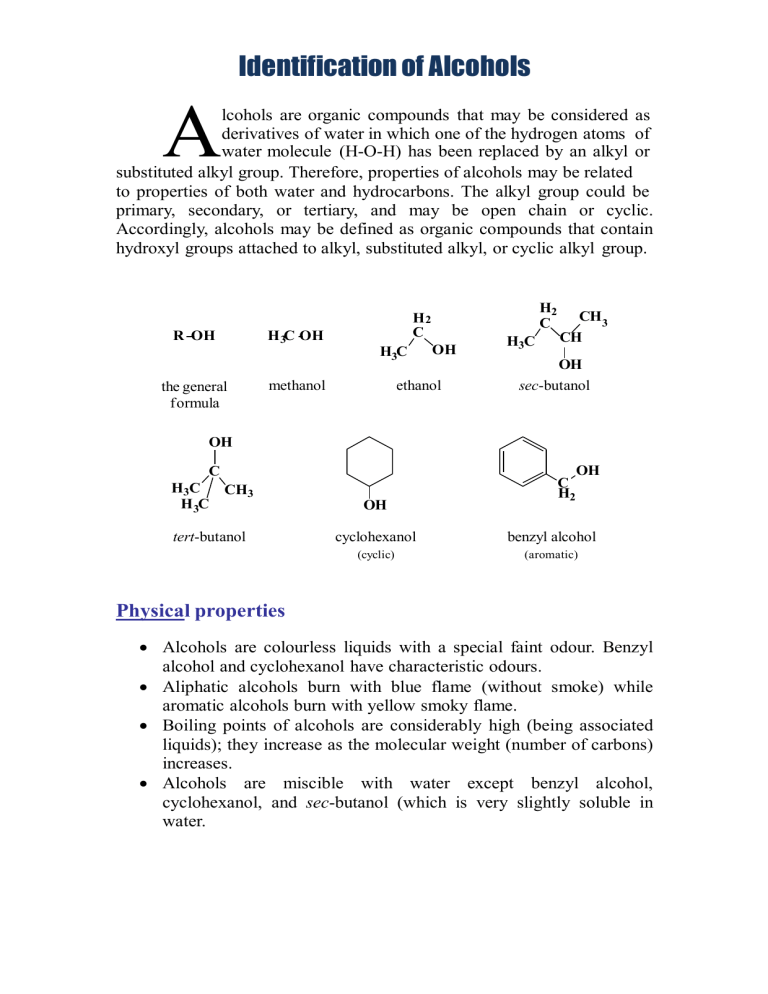
Identification of Alcohols A lcohols are organic compounds that may be considered as derivatives of water in which one of the hydrogen atoms of water molecule (H-O-H) has been replaced by an alkyl or substituted alkyl group. Therefore, properties of alcohols may be related to properties of both water and hydrocarbons. The alkyl group could be primary, secondary, or tertiary, and may be open chain or cyclic. Accordingly, alcohols may be defined as organic compounds that contain hydroxyl groups attached to alkyl, substituted alkyl, or cyclic alkyl group. R OH H 3C OH H3C the general formula H2 C H2 C methanol OH ethanol H3C CH3 CH OH sec-butanol OH C C H2 OH H3C CH3 H 3C OH tert-butanol cyclohexanol benzyl alcohol (cyclic) (aromatic) Physical properties Alcohols are colourless liquids with a special faint odour. Benzyl alcohol and cyclohexanol have characteristic odours. Aliphatic alcohols burn with blue flame (without smoke) while aromatic alcohols burn with yellow smoky flame. Boiling points of alcohols are considerably high (being associated liquids); they increase as the molecular weight (number of carbons) increases. Alcohols are miscible with water except benzyl alcohol, cyclohexanol, and sec-butanol (which is very slightly soluble in water. Solubility classification Alcohols are polar compounds because of the presence of the hydroxyl group which is also responsible for their ability to form hydrogen bonding. The degree of the polarity depends on the size of the alkyl side chain; the polarity decreases as the size of the alkyl side chain increases, or in another word, as the hydroxyl group /hydrocarbon ratio of alcohols increases, their water solubility increases and vice versa. Besides, low molecular weight alcohols are soluble in water due to hydrogen bonding ability with water molecules. Therefore, alcohols that are soluble in water and ether are classified under class S1 such as ethanol and methanol. Alcohols that are insoluble in water are related to class N such as benzyl alcohol, sec-butanol, and cyclohexanol. Which alcohol has solubility class S2, what are the structural requirements present in this alcohol that made it under this solubility class? Chemical properties Alcohols are neutral compounds that don’t change the colour of litmus paper. All reactions of alcohols are related to its active hydroxyl group and are of two types: a) removal of the hydroxyl itself as in the reaction with hydrogen halides to form alkyl halides or in the dehydration reaction to form a double bond. b) removal of the proton only from the active hydroxyl as in the formation of esters or in the reaction with active metals such as sodium. 1. General test (Ceric ammonium nitrate reagent) Ceric ammonium nitrate (yellow solution) is an oxidizing agent that reacts with alcohols to give a red complex and with phenols to give a brown to greenish brown precipitate. O 2[(NH4 )2 Ce(NO3 )6]+ RCH2OH ceric ammonium nitrate alcohol RC H + 2[(NH4 )2 Ce(NO3 )5]+ 2HNO3 aldehyde Each mole of the alcohol requires two moles of the reagent. The red coloured complex is an intermediate for the oxidation of alcohols by the Ce (IV) solution. This red colour disappears after a reasonable time due to completing the oxidation of this intermediate and the reduction to the colourless Ce (III) solution producing the corresponding aldehyde or ketone. OR (NH4)2Ce(NO3)6 + ROH ceric ammonium nitrate (NH4)2Ce(NO3)5 + HNO3 alcohol (yellow) (red) Procedure Water soluble (miscible) alcohols; mix two drops of the alcohol with one drop of ceric ammonium nitrate solution. A red complex indicates a positive test. Water insoluble (immiscible) alcohols; mix two drops of the alcohol with 0.5 ml dioxane, shake well, and add one drop of the reagent to get a positive red complex. This test gives positive results with primary, secondary, and tertiary alcohols (up to 10 carbons), poly hydroxylated compounds such as carbohydrates, and hydroxylated carboxylic acids, aldehydes and ketones. 2. Specific tests a) Iodoform (Haloform) test This test is specific for alcohols which have a free methyl group and a hydrogen attached to the carbon bearing the hydroxyl group such as ethanol and sec-butanol. OH H3C C H The overall reaction is: The alcohol is oxidized to the corresponding aldehyde or ketone by the action of the produced oxidizing agent 'sodium hypoiodite', which also causes the aldehyde or ketone to be tri-iodinated on the terminal methyl group producing iodoform as a yellow precipitate. Procedure (Note: read the procedure carefully and completely before starting) Dissolve about 3 drops of the alcohol in about 2 mL of distilled water (or 2 mL of dioxane for water insoluble compounds), add about 1 ml of 10% sodium hydroxide solution, then add iodine solution drop wise with shaking until either a yellow iodoform precipitate is formed, in which case the test is positive and is completed, or the dark colour of the iodine solution is present. In the latter case allow the solution to stand for 3 minutes during which period check for the appearance of the yellow precipitate at the bottom of the test tube. If there is no precipitate, warm the solution in water bath (60 ˚C) for about 3 minutes with shaking from time to time and check for the yellow precipitate. During warming, if the colour of iodine disappears, add few additional drops of iodine solution with shaking until either the yellow precipitate is formed or the dark iodine colour persists, and then complete warming. Then get rid of the excess iodine by the addition of 10% sodium hydroxide solution drop wise with shaking to obtain the yellow precipitate. If the precipitate is not formed, allow the solution to stand for 10 minutes to get the positive result. Finally if no precipitate is formed after the 10 minutes- standing period, dilute the solution with an equal volume of distilled water to obtain the iodoform precipitate. It is important to proceed through all these steps so that only at the final step you can say that the test is negative. Both ethanol and sec-butanol give positive iodoform test and they can be differentiated only by testing their solubility in water; sec-butanol is less soluble in water than ethanol. b) Lucas test This test often provides classification informations on alcohols and is used to distinguish between the different types of alcohols (primary, secondary, or tertiary). It depends on the formation of alkyl chloride as a second liquid phase. Lucas reagent is prepared from anhydrous zinc chloride and concentrated hydrochloric acid. Zinc chloride is added to increase the ionization of hydrochloric acid. - ZnCl2 + HCl ZnCl3 + H + Benzyl alcohol shows the fastest positive result. Tertiary alcohols are faster in the formation of conjugated halides than secondary alcohols. Primary alcohols and methanol don’t react and don’t form two layers. R R R C OH + HCl R tertiary alcohol ZnCl2 R C Cl R tertiary alkyl halide insoluble in water + H2O Procedure Mix 2-4 drops of the alcohol with few drops of Lucas reagent and observe the results: benzyl alcohol gives immediate result as shown by the appearance of two phases. tertiary alcohols give two phases that separate within 2-3 minutes. secondary alcohols give two phases that separate after 15-20 minutes (giving a cloudy solution). in primary alcohols one layer appears.
